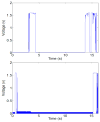Handheld micromanipulator for robot-assisted stapes footplate surgery
- PMID: 23366167
- PMCID: PMC3561930
- DOI: 10.1109/EMBC.2012.6346206
Handheld micromanipulator for robot-assisted stapes footplate surgery
Abstract
Stapes footplate surgery is complex and delicate. This surgery is carried out in the middle ear to improve hearing. High accuracy is required to avoid critical tissues and structures near the surgical worksite. By suppressing the surgeon's tremor during the operation, accuracy can be improved. In this paper, a fully handheld active micromanipulator known as Micron is evaluated for its feasibility for this delicate operation. An ergonomic handle, a custom tip, and a brace attachment were designed for stapes footplate surgery and tested in a fenestration task through a fixed speculum. Accuracy was measured during simulated surgery in two different scenarios: Micron off (unaided) and Micron on (aided), both with image guidance. Preliminary results show that Micron significantly reduces the mean position error and the mean duration of time spent in specified dangerous zones.
Figures








Similar articles
-
Robot assisted stapedotomy ex vivo with an active handheld instrument.Annu Int Conf IEEE Eng Med Biol Soc. 2015;2015:4879-82. doi: 10.1109/EMBC.2015.7319486. Annu Int Conf IEEE Eng Med Biol Soc. 2015. PMID: 26737386 Free PMC article.
-
Manual accuracy in comparison with a miniature master slave device--preclinical evaluation for ear surgery.Stud Health Technol Inform. 2011;163:524-30. Stud Health Technol Inform. 2011. PMID: 21335850
-
[A surgical micromanipulator in ear surgery: potential and comparison to freehand preparation].HNO. 2012 Feb;60(2):109-16. doi: 10.1007/s00106-011-2374-0. HNO. 2012. PMID: 22331085 German.
-
Physical characteristics of various lasers used in stapes surgery.Adv Otorhinolaryngol. 2007;65:237-249. doi: 10.1159/000098838. Adv Otorhinolaryngol. 2007. PMID: 17245054 Review.
-
Laser-assisted endoscopic stapedectomy: a prospective study.Laryngoscope. 2000 May;110(5 Pt 2 Suppl 95):1-37. doi: 10.1097/00005537-200005001-00001. Laryngoscope. 2000. PMID: 10807349 Review.
Cited by
-
Positioning Accuracy in Otosurgery Measured with Optical Tracking.PLoS One. 2016 Mar 30;11(3):e0152623. doi: 10.1371/journal.pone.0152623. eCollection 2016. PLoS One. 2016. PMID: 27027500 Free PMC article.
-
Robot assisted stapedotomy ex vivo with an active handheld instrument.Annu Int Conf IEEE Eng Med Biol Soc. 2015;2015:4879-82. doi: 10.1109/EMBC.2015.7319486. Annu Int Conf IEEE Eng Med Biol Soc. 2015. PMID: 26737386 Free PMC article.
-
Middle-ear microsurgery simulation to improve new robotic procedures.Biomed Res Int. 2014;2014:891742. doi: 10.1155/2014/891742. Epub 2014 Jul 23. Biomed Res Int. 2014. PMID: 25157373 Free PMC article.
-
A cadaver study of mastoidectomy using an image-guided human-robot collaborative control system.Laryngoscope Investig Otolaryngol. 2017 Sep 25;2(5):208-214. doi: 10.1002/lio2.111. eCollection 2017 Oct. Laryngoscope Investig Otolaryngol. 2017. PMID: 29094065 Free PMC article.
References
-
- Shea JJ., Jr Forty years of stapes surgery. Am J Otol. 1998;19:52–55. - PubMed
-
- Sedwick JD, Louden CL, Shelton C. Stapedectomy vs stapedotomy: Do you really need a laser? Arch Otolaryngol Head Neck Surg. 1997;123(2):177–180. - PubMed
-
- Rothbaum DL, Roy J, Stoianovici D, Berkelman P, Hager GD, Taylor RH, Whitcomb LL, Francis HW, Niparko JK. Robot-assisted stapedotomy: micropick fenestration of the stapes footplate. Otolaryngol Head Neck Surg. 2002;127:417–426. - PubMed
-
- Kazmitcheff G, Miroir M, Nguyen Y, Celerier C, Mazalaigue S, Ferrary E, Sterkers O, Grayeli AB. Evaluation of command modes of an assistance robot for middle ear surgery. Proc IEEE Intl Conf Intell Robot Syst. 2011:2532–2538.
Publication types
MeSH terms
Grants and funding
LinkOut - more resources
Full Text Sources
